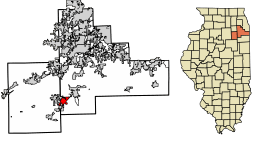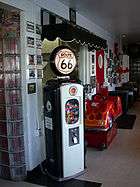Braidwood, Illinois
| Braidwood | |
|---|---|
| City | |
 Location of Braidwood in Will County, Illinois. | |
.svg.png) Location of Illinois in the United States | |
| Coordinates: 41°16′19″N 88°13′6″W / 41.27194°N 88.21833°WCoordinates: 41°16′19″N 88°13′6″W / 41.27194°N 88.21833°W | |
| Country | United States |
| State | Illinois |
| County | Will |
| Area[1] | |
| • Total | 5.53 sq mi (14.33 km2) |
| • Land | 5.36 sq mi (13.88 km2) |
| • Water | 0.17 sq mi (0.45 km2) |
| Population (2010) | |
| • Total | 6,191 |
| • Estimate (2016)[2] | 6,157 |
| • Density | 1,148.91/sq mi (443.57/km2) |
| Time zone | UTC-6 (CST) |
| • Summer (DST) | UTC-5 (CDT) |
| Area code(s) | 815/779 |
| FIPS code | 17-07770 |
| Wikimedia Commons | Braidwood, Illinois |

Braidwood is a city in Will County, Illinois, United States, approximately 53 miles (85 km) southwest of Chicago and 18 miles (29 km) south of Joliet. The population was 5,203 at the 2000 census.
The Braidwood Nuclear Generating Station, a nuclear power plant currently owned by Exelon Corporation, is also located in the area (although the plant's address is actually in the nearby town of Braceville). The station is one of the major employers in the area and provides a significant portion of the electricity used in the Chicago area.
Reed-Custer Community Unit School District 255 educates students from in and around Braidwood, Custer Park, Essex, and Godley. The district has 3 schools: Reed-Custer Elementary School (Grades PreK-5), Reed-Custer Middle School (Grades 6-8), and Reed-Custer High School (Grades 9-12). The district level administrators are: Mark Mitchell (Superintendent), Christine Nelson (Assistant Superintendent), and Jim King (Director of Operations).
Reed-Custer High School is located in Braidwood. Reed-Custer High School is located at 249 Comet Drive in Braidwood, IL 60408. The principal at RCHS is Tim Ricketts. RCHS is part of the Reed-Custer School District known as 255U. The school mascot is known as "Comets". RCHS offers numerous classes that vary on many different subjects that are not just core classes.
Geography
Braidwood is located at 41°16′19″N 88°13′6″W / 41.27194°N 88.21833°W (41.271982, -88.218221).[3]
According to the 2010 census, Braidwood has a total area of 4.764 square miles (12.34 km2), of which 4.58 square miles (11.86 km2) (or 96.14%) is land and 0.184 square miles (0.48 km2) (or 3.86%) is water.[4]
Demographics
| Historical population | |||
|---|---|---|---|
| Census | Pop. | %± | |
| 1880 | 5,524 | — | |
| 1890 | 4,641 | −16.0% | |
| 1900 | 3,279 | −29.3% | |
| 1910 | 1,958 | −40.3% | |
| 1920 | 1,297 | −33.8% | |
| 1930 | 1,161 | −10.5% | |
| 1940 | 1,354 | 16.6% | |
| 1950 | 1,485 | 9.7% | |
| 1960 | 1,944 | 30.9% | |
| 1970 | 2,323 | 19.5% | |
| 1980 | 3,429 | 47.6% | |
| 1990 | 3,584 | 4.5% | |
| 2000 | 5,203 | 45.2% | |
| 2010 | 6,191 | 19.0% | |
| Est. 2016 | 6,157 | [2] | −0.5% |
| U.S. Decennial Census[5] | |||
As of the census[6] of 2000, there were 5,203 people, 1,843 households, and 1,422 families residing in the city. The population density was 1,124.0 people per square mile (433.9/km²). There were 2,305 housing units at an average density of 497.9 per square mile (192.2/km²). The racial makeup of the city was 97.48% White, 0.27% African American, 0.10% Native American, 0.33% Asian, 0.79% from other races, and 1.04% from two or more races. Hispanic or Latino of any race were 2.83% of the population. Was also known by Blacks to be a "sundown town".
There were 1,843 households out of which 39.8% had children under the age of 18 living with them, 62.3% were married couples living together, 9.5% had a female householder with no husband present, and 22.8% were non-families. 18.5% of all households were made up of individuals and 6.2% had someone living alone who was 65 years of age or older. The average household size was 2.81 and the average family size was 3.20.
In the city, the population was spread out with 29.5% under the age of 18, 8.6% from 18 to 24, 32.2% from 25 to 44, 20.9% from 45 to 64, and 8.8% who were 65 years of age or older. The median age was 34 years. For every 100 females, there were 101.3 males. For every 100 females age 18 and over, there were 98.4 males.
Early history
In 1864, a farmer digging for water at the site of the present city found coal instead. Deposits were substantial and the demand for coal in nearby Chicago was high, so companies rushed to acquire land and set up operations. A mining boomtown sprang up, a post office was established in 1867 (which was later burnt down in 1969 by Vietnam protesters.), and the community was called Keeversville, The Grove. James Braidwood was an early member of the community, and in 1872 he was hired by one company to superintend the sinking of the first deep mine shaft. The addition of more deep-shaft mines followed, and on March 4, 1873 the city was incorporated[7] and named in Braidwood's honor. There was an initial population of about 2,000 that would grow to 8,000, making Braidwood the second largest city in Will County at that time.
Businesses and the lives of residents were centered on the coal mines, with economic prosperity and depression occurring in their turn. Mines cut back operations during summer months, when warm weather reduced the demand for coal, leaving many miners unemployed. The disputes between coal companies and miners over wages and working conditions were always rancorous and often violent, typical for the late nineteenth and early twentieth centuries.
On February 16, 1883, the Diamond Mine in Braidwood was suddenly flooded, resulting in the deaths of 73 miners.
There was a combination of ethnicities, providing religious and cultural diversity. At first most miners were Americans or immigrants from northern Europe. African Americans arrived from West Virginia, and many later residents would arrive as immigrants from eastern and southern Europe.[8][9][10]
Notable people
- Kay Cannon, writer (30 Rock); Emmy nominee
- Anton Cermak, immigrant from Bohemia and the 34th mayor of Chicago; worked as a miner in Braidwood.[11]
- Brian Dubois, pitcher with the Detroit Tigers; played in the state championships with Reed-Custer High School[12]
- Artie Matthews, a songwriter, pianist, and ragtime composer; born in Braidwood (1888)
- John Mitchell, early UMW president; born in Braidwood (1870, before incorporation); worked in the local mines as a child
- Les Norman, outfielder with the Kansas City Royals; played in the state championships with Reed-Custer High School[13]
- Doug Pinnick, songwriter, bassist, and co-lead singer for rock band King's X; born and raised in Braidwood
Cultural references
- "Braidwood" is a song by indie rockers The Samples, written by Andy Sheldon. It appears on their third album, Underwater People, released in 1991.
- Braidwood Inn (now the Sun Motel) was featured in the film Planes, Trains and Automobiles.[14][15]
Tritium contamination fake report
The Braidwood Nuclear Generating Station has been the subject of recent controversy surrounding the discovery of tritium contamination ,
Notes
- ↑ "2016 U.S. Gazetteer Files". United States Census Bureau. Retrieved Jun 29, 2017.
- 1 2 "Population and Housing Unit Estimates". Retrieved June 9, 2017.
- ↑ "US Gazetteer files: 2010, 2000, and 1990". United States Census Bureau. 2011-02-12. Retrieved 2011-04-23.
- ↑ "G001 - Geographic Identifiers - 2010 Census Summary File 1". United States Census Bureau. Retrieved 2015-12-25.
- ↑ "Census of Population and Housing". Census.gov. Archived from the original on May 12, 2015. Retrieved June 4, 2015.
- ↑ "American FactFinder". United States Census Bureau. Archived from the original on 2013-09-11. Retrieved 2008-01-31.
- ↑ Adams, James N. (compiler) (1989), Keller, William E., ed., Illinois Place Names, Springfield: Illinois State Historical Society, p. 301, ISBN 0-912226-24-2
- ↑ Joyce, Richard, Early Days of Coal Mining in Northern Illinois, The Illinois Labor History Society, archived from the original on 2008-05-14, retrieved 2008-02-12
- ↑ Vasco, Sandy, "Tales From Brawling Braidwood", Time Was Column, Free Press Advocate, Wilmington, Illinois, Quarterly Publication, Will County Historical Society (Fall 2001), archived from the original on 2007-08-18, retrieved 2008-02-12
- ↑ Woods, Robin F., A Story of James "Jimmie" Braidwood 1832-1879, ElectricScotland.com, retrieved 2009-05-29
- ↑ Simkin, John (September 1997). "Anton Cermak". Spartacus Educational. Retrieved 5 April 2017.
- ↑ Shnay, Jerry (6 June 1985). "Pitcher`s Brilliant Effort Gives Reed-custer Title". Chicago Tribune. Retrieved 5 April 2017.
- ↑ "Baseball Almanac Les Norman". Baseball Almanac.
- ↑ Hinckley, Jim (2012). The Route 66 Encyclopedia. Voyageur Press. p. 43. ISBN 9780760340417.
- ↑ Cadden, LuAnn; Cable, Ted (2013). Traveling Through Illinois: Stories of I-55 Landmarks and Landscapes between Chicago and St. Louis. Arcadia Publishing. ISBN 9781625845047.